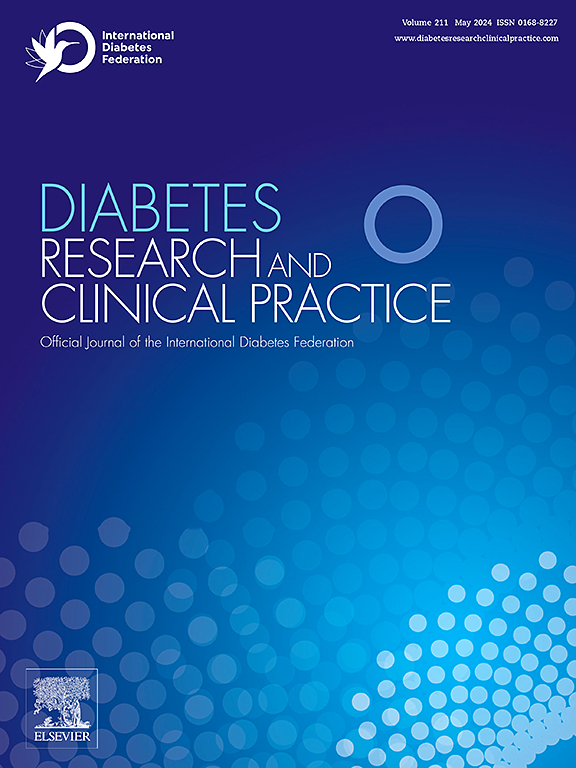身体圆度指数作为糖尿病和前驱糖尿病患者全因死亡率和心血管死亡率的预测因子。
IF 6.1
3区 医学
Q1 ENDOCRINOLOGY & METABOLISM
引用次数: 0
摘要
背景:目前有有限的基于人群的研究,探讨了糖尿病和前驱糖尿病患者的身体圆度指数(BRI)与死亡率之间的相关性。方法:我们的最终分析包括来自2003年至2018年国家健康与营养检查调查(NHANES)的15848名糖尿病和前驱糖尿病患者。利用Cox比例风险模型和限制性三次样条(RCS)来评估BRI与全因死亡率和心血管死亡率之间的相关性。结果:在平均92.9 个月的随访期间,2655名参与者(12.73 %)死亡,其中730名(3.44 %)死于心血管疾病。RCS显示BRI与全因死亡率和心血管死亡率呈u型非线性相关,阈值分别为5.54和5.21。当BRI低于阈值时,BRI与全因死亡率呈负相关(HR 0.87, 95 % CI 0.81-0.93)。与心血管疾病死亡率的相关性不显著。相反,当BRI高于阈值时,BRI与全因死亡率(HR 1.10, 95 % CI 1.06-1.14)和心血管死亡率(HR 1.13, 95 % CI 1.07-1.20)呈正相关。结论:我们的研究表明,在患有糖尿病或前驱糖尿病的美国成年人中,BRI与全因死亡率和心血管死亡率呈u型关系,阈值分别为5.54和5.21。本文章由计算机程序翻译,如有差异,请以英文原文为准。
Body roundness index as a predictor of all-cause and cardiovascular mortality in patients with diabetes and prediabetes
Background
There are limited population-based studies examining the correlation between body roundness index (BRI) and mortality in diabetes and prediabetes patients.
Method
Our final analysis encompassed 15,848 patients with diabetes and prediabetes sourced from the National Health and Nutrition Examination Survey(NHANES) spanning from 2003 to 2018. Cox proportional hazards model and restricted cubic splines (RCS) were utilized to assess the correlation between BRI and both all-cause mortality and cardiovascular mortality.
Results
During an average follow-up period of 92.9 months, 2655 participants (12.73 %) died, including 730 (3.44 %) from cardiovascular diseases. RCS demonstrated a U-shaped nonlinear association between BRI with all-cause mortality and cardiovascular mortality, with threshold values of 5.54 and 5.21, respectively. When BRI was below the threshold, a negative correlation was observed between BRI and all-cause mortality (HR 0.87, 95 % CI 0.81–0.93).The correlation with cardiovascular mortality is not significant. Conversely, when BRI was above the threshold, a positive correlation was observed between BRI with all-cause mortality (HR 1.10, 95 % CI 1.06–1.14) and cardiovascular mortality (HR 1.13, 95 % CI 1.07–1.20).
Conclusion
Our research indicates that among US adults with diabetes or prediabetes, BRI exhibits a U-shaped relationship with all-cause and cardiovascular mortality, with threshold values of 5.54 and 5.21, respectively.
求助全文
通过发布文献求助,成功后即可免费获取论文全文。
去求助
来源期刊

Diabetes research and clinical practice
医学-内分泌学与代谢
CiteScore
10.30
自引率
3.90%
发文量
862
审稿时长
32 days
期刊介绍:
Diabetes Research and Clinical Practice is an international journal for health-care providers and clinically oriented researchers that publishes high-quality original research articles and expert reviews in diabetes and related areas. The role of the journal is to provide a venue for dissemination of knowledge and discussion of topics related to diabetes clinical research and patient care. Topics of focus include translational science, genetics, immunology, nutrition, psychosocial research, epidemiology, prevention, socio-economic research, complications, new treatments, technologies and therapy.
 求助内容:
求助内容: 应助结果提醒方式:
应助结果提醒方式:


